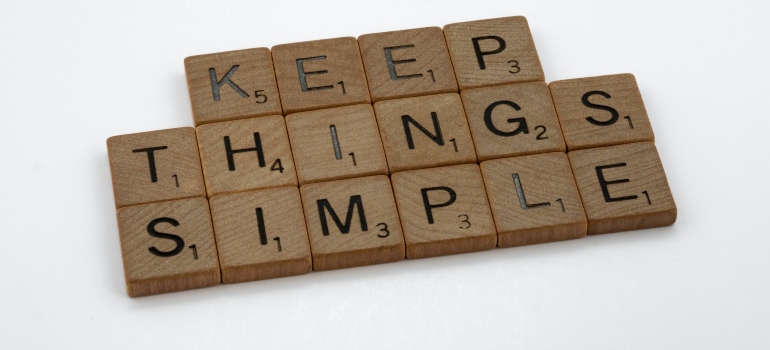Downsizing for retirement: How to choose what to store
get a quote
Beginning a fresh chapter like retirement often requires a thoughtful reevaluation of one’s belongings. All their life, people collect items, only to realize that material things are not what makes a fulfilled life. The big question then is: how to choose what to store? At PortaBox Storage, we’ve seen an increasing number of retirees taking the brave step of downsizing, seeking a more streamlined and manageable life. With this guide, we strive to make this emotional decision easier, so take a look.
Why is downsizing a smart move for retirees?
Firstly, downsizing during retirement can lead to notable financial savings. For instance, the National Association of Realtors found that over 50% of retirees moved to smaller homes, with a primary reason being cost savings. Not only does a smaller space typically come with lower rent or mortgage, but utility bills and maintenance costs also tend to decrease. Naturally, the process involves letting go of some possessions, which can be a challenging endeavor.
However, the benefits extend beyond just the financial realm. Besides saving money, you’re also curating a simpler, healthier, clutter-free environment. Imagine a home where everything has its place, and there’s no excess to worry about. It can pave the way for a peaceful and more enjoyable retirement, giving you more time to focus on hobbies, travel, or spending time with loved ones.

Distinguishing memories from necessities is mandatory when you choose what to store
Transitioning to this phase involves making a balance between emotional attachments and practicality. Many retirees grapple with deciding what to keep and what to let go. Take, for example, a dining set inherited from your grandparents. It might not fit in your new space, but it holds immense sentimental value. However, in some cases, it might be worth considering how often you use it. If it’s more of a showpiece, perhaps it’s time to capture its memory through photographs and then pass it on to someone who can use it daily.
To aid in the decision-making process, it can be helpful to categorize items based on their sentimental and functional values. Using a list or a simple rating system can make the task less intimidating and more systematic. Moreover, renting mobile storage containers Seattle locals trust can provide a clear perspective on which items are cumbersome or challenging to transport, aiding in the decision of what to store or discard.
Key areas to delve into when downsizing
Downsizing requires a systematic approach. Focusing on certain categories will streamline the process, helping you determine what stays and what goes:
- Household Items and Gadgets
- Apparel and Personal Items
- Valued Memorabilia
- Books and Collections
If you address each of these areas step-by-step, downsizing becomes a more straightforward task. This approach ensures you create an efficient and clutter-free environment.
Furniture and Appliances
Naturally, large items such as furniture and appliances are among the first to be assessed. Start by considering the size and utility of each item. For instance, a queen-sized bed might be more practical than a king-sized one in a smaller home. But no matter the size, a bed will always be difficult to carry and maneuver. It is why it is recommended to hire help to dismantle it and then keep it in self-storage West Seattle recommends until you decide what to do with it. Similarly, a compact dishwasher or microwave might serve you just as well as their larger counterparts without occupying excessive space.
Clothing and Personal Effects
Next, think about your wardrobe and personal items. Statistics from The Wall Street Journal indicate that most people only wear 20% of their wardrobe regularly. So, while downsizing, it might be an opportune moment to donate, sell, or store the remaining 80%.

Cherished Keepsakes
Transitioning to sentimental items, it’s crucial to differentiate between those that genuinely resonate and those that might just be collecting dust. A good practice is to designate a specific space or container for these items. If they start to overflow, it’s a sign that it might be time to reassess.
Books, music, and recreational collections
Lastly, in today’s digital age, consider transferring your physical collections of books, music, or movies to digital formats. Not only does this save significant space, but it also ensures that your favorite media is always just a click away.
How to choose what to store, where and how
Transitioning into the storage phase, it’s crucial to consider the conditions in which your possessions will be kept. Your chosen items are a reflection of your memories, values, and, sometimes, years of investment. So, safeguarding them is imperative.
First and foremost, temperature-controlled storage units are a boon for preserving the integrity of your belongings. These units ensure that items like wooden furniture and even fabrics remain in pristine condition, unaffected by temperature changes. For those in the Pacific Northwest, looking into on demand storage Seattle residents use might be a wise choice, given the region’s climate.
Moreover, organization is the cornerstone of efficient storage. Utilizing shelving units, transparent bins, and label systems can make the retrieval of items much easier. Similarly, packing is another area where attention to detail matters immensely. Sturdy boxes, bubble wrap, and packing peanuts can prevent potential damage during transport and storage. After all, understanding how to decide what to store also involves ensuring they are stored correctly.
Why outside opinions matter
It’s often said that two heads are better than one, and this adage holds especially true when downsizing. While the task might seem personal, seeking an external perspective can provide invaluable insights. Friends or family can offer objective advice, helping you differentiate between items you love and those you’re just accustomed to having around.
Furthermore, professional organizers or downsizing experts can bring a structured approach to the decluttering process, making it efficient and less emotionally taxing. Their expertise can guide you on how to choose what to store, ensuring that the retained items genuinely resonate with your future plans and lifestyle.

Relishing in the freedom of less
Stepping into this phase, the act of decluttering and letting go does more than just free up physical space; it also leads to emotional liberation. There’s a certain exhilaration that comes with reducing one’s possessions, a sentiment echoed by many who advocate the minimalist lifestyle and practices.
Financially, selling surplus items can provide additional funds for your retirement. Platforms like eBay or Facebook Marketplace offer easy avenues for selling used goods. On the other hand, donating can bring immense satisfaction, knowing that your items are benefiting someone in need.
Once you choose what to keep, it’s time to enjoy the benefits!
Concluding our guide on how to choose what to store, it’s evident that downsizing, while challenging, ushers in a series of benefits that can greatly enhance your retirement years. Hence, by making informed decisions on what to retain and what to relinquish, you prepare for a future that’s not bogged down by material possessions but is instead rich in experiences and memories. Embrace the transition, and remember, in the journey of retirement, less often equates to more.
